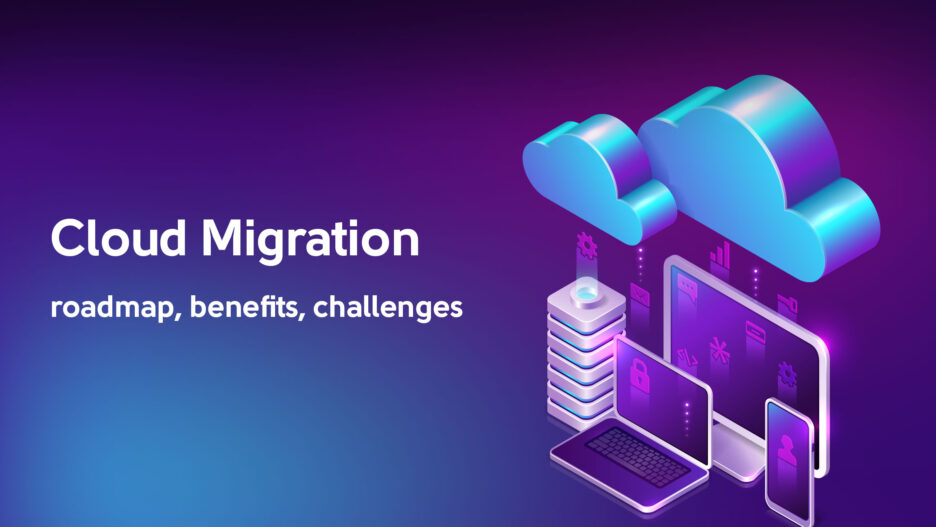It’s safe to say that in the next few years, we can expect a myriad of converging technologies and customer expectations to reshape how work gets done, how applications are consumed, and the way data is collected, stored, processed, and analyzed.
Pandemic-fueled behaviors and technology trends promise substantial changes, and those equally dynamic changes need to be met with a robust cloud strategy to connect digital transformation efforts with innovation and modern business demands.
Organizations need to shape their future by planning for and understanding how their processes and workloads will be influenced by technological shifts over the next decade, making cloud migration strategies even more critical to ensure goals align with the organization’s strategies for the workplace, digital enablement, and data processing.
Easier said than done, there’s plenty of confusion to cut through, as well as time and cost constraints that need to be accounted for.
In this blog, we’ll be covering the most essential aspects of your cloud migration roadmap. The benefits you’ll take advantage of and the potential challenges you need to take into consideration, all with the goal of helping you take concrete steps in your cloud journey.
Cloud migration benefits
Cloud is no longer a trend, it’s a necessity. Organizations need to migrate their on-premises applications and modernize their systems with a robust cloud migration strategy that leverages the agility, speed, nimbleness, computing power, and cost-effectiveness the cloud offers.
Some of the biggest public cloud providers in the industry include Amazon Web Services (AWS), Google Cloud Platform, and Microsoft Azure, to name a few. Based on your organization’s workloads, you will be able to determine which solution fits you better.
A robust cloud migration strategy prioritizes costs, workloads, computing power, documentation, architecture, availability, disruption, community, and more, to adjust, tweak, and adapt to the modern business demands of your business. Every organization is unique, so your cloud migration strategy should be tailored to your unique needs.
These are the most prominent benefits of employing a carefully planned cloud migration strategy:
- Cost-effectiveness. On-premises applications are notoriously known for being expensive to maintain. Planning a cloud migration journey will help you map out your workloads’ sources and outputs, which can be different at every layer. Migration can take months or years if this mapping exercise is not accurately performed, sending your costs through the roof.
- Application modernization. When the pandemic was declared in 2020, there was a monumental shift in the way work is performed. Entire workforces and workloads moved to an online space, bringing application modernization to the center of every IT conversation. Modern, containerized app workloads are the norm, which means that organizations need to be cloud-ready within the next five years as accelerated by the global health crisis.
- Scalability at your fingertips. Cloud migration strategies help tap into the power of being highly scalable as a result of being in the cloud. Cloud-based applications are easy to scale up and down and are always available.
- Improved security. Cloud-based applications give users the ability o access app data from anywhere at any time. Because the cloud is so easily accessible from virtually anywhere, vulnerabilities rear their ugly heads and create cracks where cybercriminals can slip through and attack. A strong cloud migration strategy gives organizations more control over the different security layers they want to embed their applications.
Cloud migration strategy
The 6 Rs of cloud migration strategies are: retire, retain, rehost, replatform, refactor, and re-archiect, which we’ll explore in detail next:
- Retiring. Detect the areas of your business with the potential to be easily migrated to the cloud and identify the users in each of those workloads to determine impact. Define which workloads or functionality can be retired or replaced with standard cloud functions.
- Retaining. Not every element of your workload is meant to be migrated to the cloud and need to be retained as-is. For example, components where the cost of migration is simply too high or they are still riding the deprecation value wave.
- Rehosting. Popular migration technique that many people in the industry refer to as “lift and shift”. Rehosting serves as a quick fix to move specific workloads to the cloud with little effort. For those who are new to the cloud, rehosting is the go-to option because it involves moving physical and virtual servers to an IaaS solution. There, you can find infrastructures like servers, networking hardware, storage, and a virtualized environment.
- Replatforming. Mature enterprises typically favor this option as it allows them to emulate their applications through a virtual machine so legacy systems become compatible with cloud technologies. This option can be costly but it’s a good fit for organizations that can’t restructure their legacy systems for a full-fledged cloud migration effort.
- Refactoring/rearchitecting. Usually favored by organizations looking to add features or access superior scalability functionality, refactoring helps boost agility, productivity, and collaboration. This is usually the most expensive of all options.
- Repurchasing. Straightforward and fast, you can simply repurchase your application as a cloud-based application to access SaaS capabilities tailored to your unique business needs.
Cloud migration is the most immediate reality for organizations looking to meet modern demands and support healthy operability. Outdated hardware and data centers bring more headaches than moving to the cloud, but you must comprehensively assess how to manage an application’s cloud migration before embarking on such a monumental project.
How to manage application cloud migration
Cloud migrations are not cheap or hassle-free, yet the benefits far outweigh the challenges. Still, you need to plan ahead to ensure those challenges are properly understood, so here they are:
- Budget gone wild. Migrating to the cloud doesn’t come with an instruction manual or metrics you can benchmark to see how well you’re doing it, but luckily, there are several things you can watch out for when it comes to costs to make sure you don’t blow your budget.
- Data safety and compliance. It’s all about data these days, and it’s actually one of the things that put organizations very wary about embarking on a cloud migration journey. Cloud services have a shared responsibility model where they pledge to secure the infrastructure but you are responsible for securing data and workloads. It falls on you to set security controls in place to configure the offered security measures. Transferring massive volumes of data creates exposure and risks of data leaks, so it’s important that you pay close attention to this challenge.
So, what are the cloud migration steps you can take to make your life easier? We have you covered:
- Planning. Determine the use case the cloud will address for your organization. Take a hard look at your environment and workloads to detect the aspects that will impact the migration like legacy code, interoperability, critical data, data reliance, and more. By having a clear picture of these elements, you will be able to map out a comprehensive roadmap of the tools and resources you’ll need during the migration.
- Building a business case. Justifying the cloud migration is an exercise to understand the cloud services you will leverage the most, their benefits, and costs. Building the business case to migrate to the cloud validates that the business requirements you outlines in the planning phase are realistic and will bring true value to your organization. Consider your storage needs, computing resources, operating systems, network requirements, and more, when building your business case in the cloud. Understand and compare the different services cloud providers offer, as well as their pricing models, to determine which one works best for you.
- Executing the migration. The key to successful cloud migration is to take all measures necessary to ensure minimal disruption to your day-to-day operations, at the lowest cost, in the shortest period of time. Sounds easy enough, right? Well, if you have your planning and business case nailed down, you will find that executing the actual migration will be pain-free, but still, there are risks and things that can go wrong, no matter how much you plan. Make sure to test workload elements to validate the migration is successful.
- Post-migration maintenance. Be sure to keep your data and workloads in the cloud-optimized, secure, and easy to manage. Monitor changes, anomalies, or any other indicator that can help you assess system security or predict future workloads.
Google Cloud Migration
Google’s Cloud Platform is public and a direct competitor of Amazon Web Services (AWS) and Microsoft Azure, which we’ll cover next.
The Google Cloud Platform (GCP) is fairly small when compared to the other two cloud giants but is quickly making strides thanks to its unique focus on modern, containerized workloads as well as the ability to run AI-based models. that continuously learn.
Some of the key advantages of GCP are:
- Costs. With GCP, you get charged by the second and are eligible for discounts if your instances are long-running. Organizations love the 40-50% lower costs than other options.
- Migration. You can migrate workloads between virtual machines with virtually no downtime.
- Privacy. Thanks to Google’s private global fiber-optic network, you can get fast direct interconnectivity between your organization’s data centers.
- Security. The security measures across all Google products are enterprise-grade and on a global scale.
AWS Cloud Migration
AWS is probably the biggest name as of yet when it comes to public clouds. With more than 100 cloud computing services resting on top of AWS’s Infrastructure as a Service (IaaS), you have all that you need to configure a scalable, rich, automated computing environment.
Many favor AWS because of its affordability, resource utilization, and new infrastructure capabilities, making it the preferred choice for plenty of organizations. Here are some of the AWS cloud migration benefits that make it a favorite in the industry:
- Functionality. AWS has more services and more features than any other cloud provider. Whether you need storage, databases, artificial intelligence, data lakes, Internet of Things capabilities, and more, AWS is a one-stop shop where you can find everything in a faster, easier, and cost-effective way.
- Community. Because almost everyone is using AWS, it’s safe to say it also has the largest, most enriching community of global partners, from startups to enterprises to public sector organizations. The AWS Partner Network is packed with thousands of system integrators who are specialists in AWS services.
- Security. The AWS architecture is flexible and secure; it’s meant to meet and/or exceed the requirements of military-grade enterprises, global banks, and other high-sensitivity organizations with 230 security, compliance, and governance services and features. AWS also supports 90 security standards and compliance certifications.
Case in point: AWS Cloud Migration in Less Than 3 Months
Azure Cloud Migration
Azure Cloud is the final piece of the most popular cloud providers’ trifecta. Created by Microsoft, Azure Cloud offers reduced IT costs and improved performance. Packed with more than 200 cloud services and products, this platform is designed to solve modern challenges like managing applications across multiple clouds, on-premises, and at the edge.
Many organizations favor Azure Cloud because:
- It comes with more than 90 compliance offerings, making it the largest portfolio in the industry;
- It’s used by more than 55% of Fortune 500 companies;
- It invests more than $1 billion a year in cybersecurity to protect customer data;
- It’s future-ready thanks to continuous improvement methodologies from Microsoft.
Case in point: Azure Cloud as a Platform for a Transplantation Management App
Cloud migration challenges
Migrating to the cloud is a monumental feat, one that must be taken with care and precaution. As we’ve been emphasizing throughout this blog piece, having a cloud migration strategy makes all the difference and can make your cloud migration journey a breeze.
A cloud migration strategy is basically a cloud migration project plan, a high-level one where organizations outline why and how they’ll be moving their on-premises applications to the cloud, either completely or for certain workloads only. Most strategies include a public cloud migration tailored to either GCP, AWS, or Azure Cloud.
Like with all plans, your cloud migration journey will most likely come with some challenges, issues, or delays. Here are some of the most prominent cloud migration challenges you can expect:
- Not having a clear end state. Most often than not, organizations want to leap to the cloud, all in, but that’s not how it works. Realistically, you need to define your cloud migration’s end state to know when you’ve reached specific milestones.
- Security concerns. Thanks to its shared responsibility model, the cloud needs to be secured with a zero-trust approach via stateless transactions. While that’s not always the case, you may expose your operations to unwanted vulnerabilities.
- Governance and compliance. Every region is different, same as their regulations. You need to research which regulations are applicable to you and see how cloud providers can help you adhere to those regulatory mandates and be compliant.
- Costs. Costs can easily get out of hand during a cloud migration, so be sure to validate workloads migrate successfully without needless replications.
Migrate to the cloud successfully
Every organization needs to have a cloud migration strategy in the next 10 years, to say the least. Recent world events and health crises paint an even clearer picture of why moving workloads to the cloud is a necessary and evolutionary step to cope with modern business demands.
Now, as workers and workplaces go fully remote, on-premises applications continue to become more outdated, with legacy code that is hard to maintain by your internal IT staff. Plus, it’s probably costing you way more than if you were migrated to the cloud.
At Svitla Systems, we’ve helped countless clients migrate to the cloud successfully, always paying special attention to their unique requirements and business scenarios to take concrete and smart steps towards the right cloud solution.
With lots of noise surrounding the cloud, our experts can help you cut through the haze and land on a robust yet straightforward cloud migration strategy so your migration journey is smooth and effective.
If you’d like to know more about all the ways we can support you throughout your cloud migration, please reach out to our representatives.





